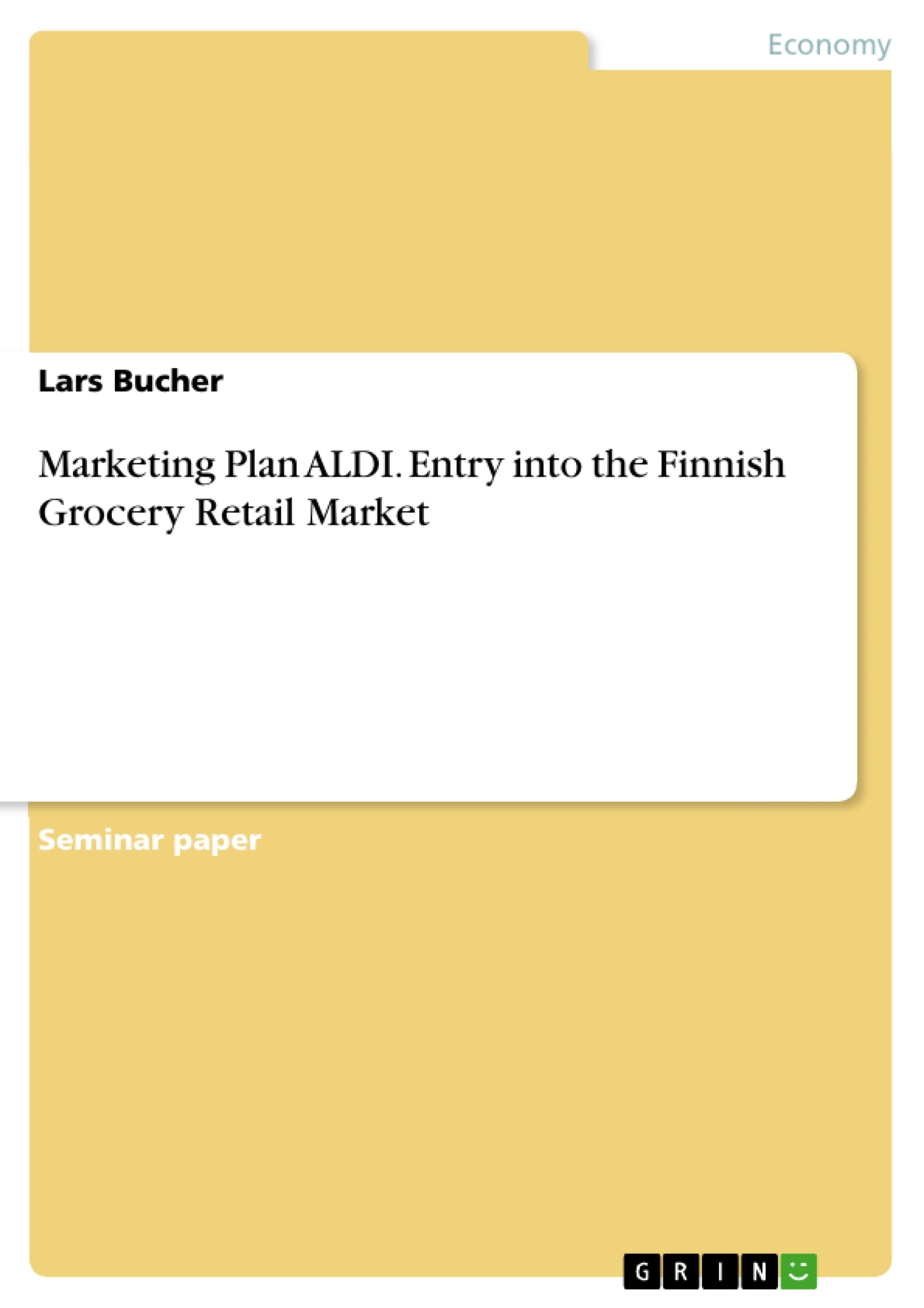The ALDI Group is known as one of the biggest chains of discounters in Europe and is still growing into more markets all over the world. As their biggest German competitor LIDL already successfully expanded into the Finnish market, Finnland could be a market of interest for ALDI as well. This project work presents an analysis of the discounters business model, capabilities and the environment of the Finnish market by using SWOT Analysis and PEST Analysis. After this a marketing plan is presented based on the insights with recommendations for the company.
Table of Contents
- Introduction
- Marketing Plan
- Self-Analysis of the Retail Company ALDI
- Key Features of the Business Model
- SWOT Analysis
- Situation Audit of the Finnish Grocery Market
- Market
- Competition
- Environmental Factors
- Retail Marketing Strategy to enter the Finnish Market
- Target Market
- Retail Offering
- Competitive Advantage
- Self-Analysis of the Retail Company ALDI
- References
Objectives and Key Themes
This marketing plan outlines ALDI's strategy for entering the Finnish grocery retail market. The objective is to assess ALDI's current strengths and weaknesses, analyze the Finnish market, and develop a comprehensive marketing strategy to ensure successful market entry and penetration.
- ALDI's business model and its core competitive advantages.
- A SWOT analysis of ALDI's position in the context of the Finnish grocery market.
- Identification of the target market within Finland.
- Development of a retail offering tailored to the Finnish consumer.
- Competitive strategies to differentiate ALDI in the Finnish market.
Chapter Summaries
Introduction: This chapter provides background information on ALDI, tracing its history and highlighting its core business model as a discounter focusing on low prices and essential goods. It discusses the company's international expansion, its presence in various markets, and the consistency of its business model despite regional adaptations to accommodate local preferences. The chapter sets the stage for a deeper analysis of ALDI's strategy and its potential for success in the Finnish market.
Marketing Plan: This section forms the core of the document and dives deep into ALDI's planned approach to entering the Finnish grocery market. It breaks the plan down into subsections to fully explore each component and their crucial role in the overall marketing strategy. A self-analysis of ALDI's existing operations precedes a comprehensive examination of the Finnish market's current state, paying attention to market trends, competitive dynamics, and environmental factors. The analysis then culminates in a detailed explanation of ALDI’s proposed market entry strategy, addressing target markets, their unique characteristics, and a tailored retail offering. A competitive advantage strategy is explained with emphasis on how it distinguishes ALDI from existing Finnish market players.
Keywords
ALDI, discount retailer, grocery market, Finland, market entry strategy, SWOT analysis, competitive advantage, low-price strategy, target market, retail offering, business model, international expansion, market analysis.
ALDI's Finnish Market Entry Strategy: Marketing Plan FAQ
What is this document about?
This document is a comprehensive marketing plan outlining ALDI's strategy for entering the Finnish grocery retail market. It includes a self-analysis of ALDI, an analysis of the Finnish grocery market, and a detailed marketing strategy for successful market entry and penetration.
What are the key objectives of ALDI's Finnish market entry?
The main objective is to assess ALDI's strengths and weaknesses, analyze the Finnish market landscape, and develop a robust marketing strategy to ensure successful market entry and penetration in Finland.
What key themes are addressed in this marketing plan?
Key themes include ALDI's business model and competitive advantages, a SWOT analysis of ALDI in the Finnish context, identification of the target market in Finland, development of a tailored retail offering for Finnish consumers, and competitive strategies to differentiate ALDI in the Finnish market.
What does the document cover in terms of ALDI's self-analysis?
The self-analysis section focuses on key features of ALDI's business model and a SWOT analysis to evaluate its internal strengths and weaknesses in relation to the Finnish market entry.
How does the document analyze the Finnish grocery market?
The Finnish market analysis examines the market size, competitive landscape (including competitors), and relevant environmental factors influencing the grocery retail sector in Finland.
What is included in ALDI's proposed retail marketing strategy?
The strategy section details ALDI's target market in Finland, its proposed retail offering (products and services), and the competitive advantages it will leverage to stand out in the Finnish market.
What is the structure of the marketing plan?
The marketing plan is structured with an introduction providing background on ALDI, followed by a detailed marketing plan section covering self-analysis, market analysis, and the proposed market entry strategy. The document concludes with a references section.
What are the key chapters and their summaries?
The Introduction provides background on ALDI and its business model. The Marketing Plan section forms the core, detailing ALDI's strategy for entering the Finnish market, including self-analysis, market analysis, and the proposed strategy. Finally, there is a References section.
What are the key words associated with this marketing plan?
Key words include ALDI, discount retailer, grocery market, Finland, market entry strategy, SWOT analysis, competitive advantage, low-price strategy, target market, retail offering, business model, international expansion, and market analysis.
- Quote paper
- Lars Bucher (Author), 2021, Marketing Plan ALDI. Entry into the Finnish Grocery Retail Market, Munich, GRIN Verlag, https://www.grin.com/document/1191422



